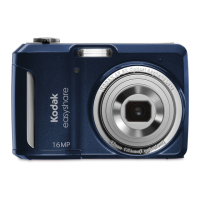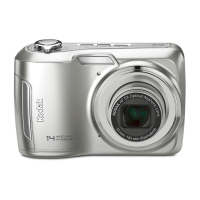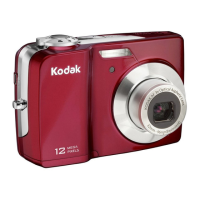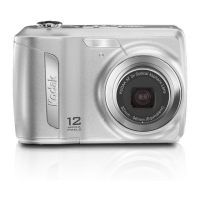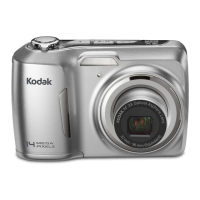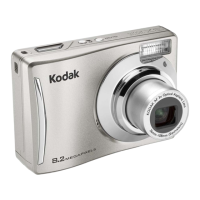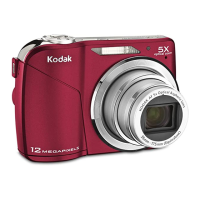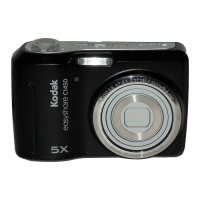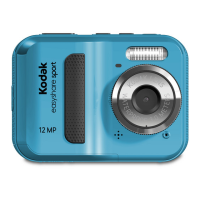How to fix Kodak EASYSHARE C1505 Digital Camera that does not turn on?
- TtylercarlsonAug 18, 2025
If your Kodak Digital Camera does not turn on, make sure the battery is charged and installed correctly.
How to fix Kodak EASYSHARE C1505 Digital Camera that does not turn on?
If your Kodak Digital Camera does not turn on, make sure the battery is charged and installed correctly.
What to do if memory card is full in Kodak EASYSHARE C1505?
If the memory card in your Kodak Digital Camera is full, you can: * Transfer the pictures to your computer. * Delete pictures from the card. * Insert a new card. * Format the card in the camera (the card may be corrupted). * Use another memory card. Only SD or SDHC Cards are supported.
Why is the battery life so short on my Kodak EASYSHARE C1505 Digital Camera?
If you are experiencing short battery life with your Kodak Digital Camera, consider the following: 1. Verify that you are using the correct battery type. 2. Wipe the battery contacts with a clean, dry cloth before inserting it in the camera. 3. Try inserting a new or fully charged battery. 4. Limit the amount of time you spend reviewing pictures or videos on the camera's LCD screen.
Why is my Kodak EASYSHARE C1505 Digital Camera picture too dark?
If your picture is too dark on your Kodak Digital Camera, try repositioning the camera to get more light. You can also use Fill flash in Program mode, Backlight in SCN mode, or adjust your position so that the light is not behind the subject. Ensure you are within the effective flash range. In Program mode, increasing the Exposure Compensation can also help.
How to fix a Kodak Digital Camera picture that is not clear?
If your picture is not clear on your Kodak Digital Camera, start by cleaning the lens. For better stability, especially in high-zoom settings or low light, place the camera on a flat, steady surface or use a tripod. Using a larger picture size can also improve clarity. If manually adjusting the ISO speed, be aware that a high ISO setting may cause grainy pictures.
Why is my Kodak EASYSHARE C1505 picture too light?
If your picture is too light on your Kodak Digital Camera, reposition the camera to reduce the amount of available light. You can also turn off the flash or ensure that you are within the effective flash range. In Program mode, decreasing the Exposure Compensation can also help.
Why doesn't the flash fire on my Kodak Digital Camera?
If the flash on your Kodak Digital Camera is not firing, check the flash setting and change it as needed. Note that the flash does not fire in all modes.
How to adjust LCD brightness on Kodak Digital Camera?
To brighten a dim LCD screen on your Kodak Digital Camera, adjust the LCD Brightness setting.
What to do if the picture count doesn't decrease on Kodak Digital Camera?
If the picture count on your Kodak Digital Camera is not decreasing after you take a picture, continue taking pictures. The camera is operating normally. The camera estimates the number of pictures remaining after each picture is taken, based on picture size and content.
What to do if memory card is full on Kodak EASYSHARE C1505?
If the memory card in your Kodak Digital Camera is full, you can transfer the pictures to your computer, delete pictures directly from the card, insert a new card, or format the card in the camera. Ensure that you are using a supported SD or SDHC card, as other types are not compatible. If the card is corrupted, formatting it within the camera may resolve the issue.
| Megapixel | 12 MP |
|---|---|
| Camera type | Compact camera |
| Sensor type | CCD |
| Image stabilizer | No |
| Image sensor size | 1/2.33 \ |
| Supported aspect ratios | 3:2, 4:3, 16:9 |
| Still image resolution(s) | 2048 x 1536, 2880 x 2160, 4000 x 2248, 4000 x 2664, 4000 x 3000 |
| Digital zoom | 5 x |
| Optical zoom | - x |
| Focal length range | - mm |
| Minimum aperture number | - |
| Minimum focal length (35mm film equiv) | 35 mm |
| Focus adjustment | Auto |
| Normal focusing range | 1.3 - ∞ m |
| Auto focusing (AF) modes | Single Auto Focus |
| Light metering | Centre-weighted, Spot |
| ISO sensitivity | 80, 100, 200, 400, 800, 1250, Auto |
| ISO sensitivity (max) | 1250 |
| ISO sensitivity (min) | 80 |
| Light exposure correction | ± 2EV (1/3EV step) |
| Fastest camera shutter speed | 1/1400 s |
| Slowest camera shutter speed | 8 s |
| Flash modes | Auto, Fill-in, Flash off, Red-eye reduction |
| Flash range (wide) | 0.3 - 2.5 m |
| Flash exposure correction | ±2EV (1/2, 1/3 EV step) |
| Flash exposure compensation | Yes |
| Minimum RAM | 1024 MB |
| Minimum processor | Intel Pentium 4 2.8GHz |
| Power source type | Battery |
| Minimum storage drive space | 300 MB |
| Minimum system requirements | CD-ROM USB VGA 1024x768 IE 6.0+ |
| Compatible operating systems | Windows XP SP2 Windows Vista Windows 7 |
| Scene modes | Backlight, Children, Fireworks, Night, Night portrait, Portrait, Self-portrait, Sports, Sunset |
| Image editing | Crop, Rotating |
| Photo effects | Black&White, Sepia, Vivid |
| White balance | Auto, Daylight, Fluorescent, Shade, Tungsten |
| Camera playback | Movie, Single image, Slide show, Thumbnails |
| Self-timer delay | 2, 10 s |
| Camera file system | Exif 2.3 |
| HD type | Not supported |
| Motion JPEG frame rate | 30 fps |
| Video formats supported | AVI, M-JPEG |
| Maximum video resolution | 640 x 480 pixels |
| Memory slots | 1 |
| Internal memory | 4.25 MB |
| Compatible memory cards | SD, SDHC |
| Display diagonal | 2.4 \ |
| Display resolution (numeric) | 112000 pixels |
| USB version | 2.0 |
| Product color | Red |
| Battery type | AA |
| Battery technology | Alkaline |
| Number of batteries supported | 2 |
| Cables included | USB |
| Depth | 17.7 mm |
|---|---|
| Width | 86.3 mm |
| Height | 50.8 mm |
| Weight | 144 g |
Identifies external buttons and components of the camera's front.
Identifies external buttons and components on the rear of the camera.
Instructions for attaching the camera's wrist strap for security.
Steps for correctly inserting batteries into the camera.
How to power the camera on using the power button.
Guide to configuring language and date/time settings on the camera.
Instructions for inserting and using SD/SDHC cards for storage.
Steps to compose and capture still images using the camera.
Procedure for recording video clips with the camera.
How to view the last captured photo or video clip.
Instructions for changing the screen brightness for better visibility.
Explanation of icons displayed during capture mode.
How to monitor the camera's battery charge status.
Guide to using the zoom feature for framing subjects.
Details on different flash modes and their operation.
Overview of various shooting modes like Auto and Scene.
Explanation of specific scene modes for various shooting situations.
How to access frequently used capture and review functions quickly.
Instructions for using the self-timer for delayed shots.
How to take multiple pictures in rapid succession.
Guide to uploading photos and videos to social media.
How to manage visible social network options on the camera.
How to add, edit, or delete email addresses and frames.
Method for adding keywords to pictures for easier searching.
How to use the on-screen keyboard for text input.
How to prepare media for sending via email.
Steps to browse through captured photos and videos.
How to play recorded video clips on the camera.
Procedure for removing unwanted photos and videos.
How to recover accidentally deleted pictures.
Method to prevent accidental deletion of media.
Options for viewing media, like magnification and thumbnails.
How to zoom in on photos for detailed viewing.
How to view multiple pictures on the screen simultaneously.
Tips for organizing and searching pictures efficiently.
Explanation of icons displayed during review mode.
Instructions for connecting the camera to a TV for playback.
How to navigate menus when in review mode.
Steps to trim unwanted parts of a picture.
How to change the orientation of a picture (portrait/landscape).
Applying enhancements for better picture quality.
How to trim and edit video clips.
Steps to shorten video clips by removing start/end sections.
How to extract a still image from a video frame.
Creating a 9-up picture from video frames.
How to select multiple items for batch operations.
How to access and modify camera settings via the menu.
Settings available in the camera's capture mode.
Adjusting exposure for lighter or darker pictures.
Controlling the camera's sensitivity to light.
Adjusting shutter open time for low-light conditions.
Selecting different color tones for pictures.
Adjusting color balance based on lighting conditions.
Controlling the sharpness or softness of pictures.
Customizing various camera settings through the Setup menu.
Settings for connecting the camera to a computer.
Options for formatting memory cards or internal memory.
Information on downloading and using Kodak camera software.
Steps to copy photos and videos from camera to PC.
Instructions for printing photos directly from the camera.
How to print photos using a Kodak printer.
Steps to connect the camera to a Kodak printer.
Options for printing various picture selections.
Steps to safely detach the camera from the printer.
Information on ordering prints via Kodak Gallery.
Ways to print photos from memory cards.
How to flag pictures for printing.
How to access the camera's built-in help system.
Steps to activate the on-camera help feature.
Common issues and their solutions for camera operation.
Solutions for issues connecting the camera to a computer.
Troubleshooting steps for PICTBRIDGE printing issues.
Solutions for common issues with picture clarity and exposure.
Resources for online support and information.
Technical details and features of the camera.
More technical specifications for the camera.
Guidelines for cleaning and maintaining the camera.
How to update the camera's software and firmware.
Information about camera storage limits and usage.
Crucial safety precautions for using the camera.
Information on battery types, replacement, and lifespan.
Tips and methods to maximize battery duration.
Details about the product's warranty terms and coverage.
Explains warranty service, exclusions, and limitations.
Information on consumer rights related to the warranty.
Warranty terms specific to regions outside the US and Canada.
Information regarding compliance with regulations like FCC.
Details on FCC compliance and potential interference.
Guidelines for environmentally responsible disposal.
Compliance statement for Canadian regulations.
Compliance and certification information for Russia.
Compliance statement for Korean regulations.

